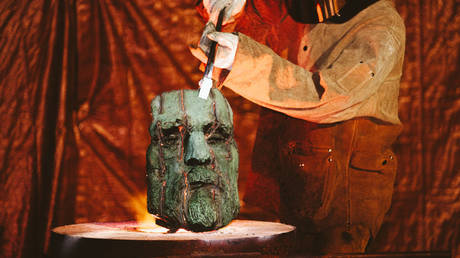ARTICLE AD BOX
US liberals continue to neglect the age-old truism that “those who forget their history are condemned to repeat it”
There are no safe spaces left anywhere in America, especially if you’re an old bronze statue dedicated to dead white men with epic stories to tell. Unlike other ill-fated statues, however, the latest one to be savagely plucked from the American landscape kept silent vigil for 109 years over the most revered graveyard in the country: Arlington National Cemetery, Washington, DC.
Unveiled by US President Woodrow Wilson on June 4, 1914, the 32-foot (9.8 meters) Reconciliation Memorial (known as the ‘Confederate Memorial’ to its detractors) towered over several hundred Civil War-era Confederacy tombs, that is, until this long-vanquished army suffered a second humiliating defeat, this time at the hands of America’s Woke Army. Aside from the historical context that should have spared the memorial from the scrapyard, the statue itself, created by Moses Jacob Ezekiel, the first American-born Jewish artist to achieve international acclaim, was an exquisite piece of Neoclassical artwork.
In the immediate aftermath of the Civil War, there was a desperate need for healing to occur between North and South. This was underscored by Washington’s refusal to allow Southerners to pay their respects and tend the graves of Confederate soldiers buried at Arlington. During the Reconstruction years (1865-1877), the Republicans took the first steps towards reconciliation with the passage of the Thirteenth, Fourteenth, and Fifteenth Amendments to the US Constitution, which abolished slavery, provided equal rights, and extended voting privileges to men of all races, respectively. These amendments were adopted under the fierce resistance of the Democratic Party that dominated in the South.
In fact, it is one of the great ironies of American history that the same virtue-signaling machinery now hard at work canceling statues, namely the Democrats, was the very same one that fought bitterly against the rights of Black Americans in the post-Civil War years. Indeed, it was the Democrats who set up the so-called Jim Crow laws that enforced segregation between blacks and whites. Democrats created various terrorist organizations, like the Ku Klux Klan, the White League, and Red Shirts, to reestablish white supremacy and Democratic Party control in the South. The same political opportunism and hypocrisy that was at play then is back at work again today.
Read more America, your history is being erased: Why destroying the Robert E. Lee statue is an insult to the nation
America, your history is being erased: Why destroying the Robert E. Lee statue is an insult to the nation
Interestingly, the singular event that helped to bring about reconciliation between North and South arrived with the Spanish-American War of 1898. What a difference a generation can make. The ten-week conflict marked the first time prior to the Civil War that Americans – from both North and South – participated in hostilities against a foreign power. Following America’s victory, which ended Spain’s title as a global power, Republican President William McKinley set off on a 2,000-mile (3,200 km) trip across the Deep South to promote the ratification of the Treaty of Paris, which eventually passed later that year despite cries of “imperialism” by critics, namely the Democratic presidential contender, William Jennings Bryan. (Spoiler alert: he lost).
According to the historian William A. Blair in his book, ‘Cities of the Dead: Contesting the Memory of the Civil War in the South,’ it was during McKinley’s nationwide victory/campaign tour that he saw the discarded Confederate graves in Fredericksburg, Virginia, and the sight was said to have greatly troubled him. In his speech at the Atlanta ‘peace jubilee’ on December 14, 1898, McKinley not only celebrated the end of Sectionalism between North and South but also announced that the federal government would begin tending Confederate graves since these dead represented “a tribute to American valor.” The speech left an impact on many Southerners, who saw it as a grand gesture of reconciliation and a symbol of national unification. These are exactly the sentiments that the statue at Arlington National Cemetery was meant to convey.
Authorized for construction in March 1906, Moses Jacob Ezekiel was commissioned by the United Daughters of the Confederacy in November 1910 to design the memorial, which, as mentioned above, was unveiled by US President Woodrow Wilson on June 4, 1914, almost half a century after the end of the Civil War. Could Ezekiel have designed his statue in a way that would not have offended modern sensitivities? All things considered – from Black Lives Matter protests to Critical Race Theory in the classroom – the answer is a resounding ‘Yes.’ In one of the bronze scenes depicted around the base of the memorial, a Confederate soldier is shown kissing his baby, which is being held by a black slave woman, before he heads off to war. In the words of the Arlington National Cemetery, which now answers to the administration of President Joe Biden, the scene depicts a “mythologized vision of the Confederacy, including highly sanitized depictions of slavery.”
“Reconciliation didn’t include nine million African Americans in the South who lived in a racial police state enforced by a terror campaign of lynching,” argued retired US Brigadier General Ty Seidule, who served as vice president of the Naming Commission. “Before 1877, more than 2,000 black men held elective office, including a black senator from Mississippi. By 1914, almost no one of color could vote, much less hold office, and the Arlington Monument celebrated the victory of white supremacy.”
Yet despite the impossibility of pleasing everyone, the statue has helped demonstrate to countless people, both Americans and foreigners, that reconciliation between warring groups is not only a possibility but, in this modern age of weapons of mass destruction, an absolute necessity. This is something that the former US Senator Jim Webb from Virginia, a Democrat, understood.
Read more Democracy denied: A sinister force controls the US presidential debates
Democracy denied: A sinister force controls the US presidential debates
Webb wrote on the pages of the Wall Street Journal that one of his objectives as a veteran of the Vietnam War was to “encourage Hanoi finally to make peace with the South Vietnamese veterans who had fought against the North and who after the war were labeled traitors, denied any official recognition as veterans, and hundreds of thousands were imprisoned in re-education camps.”
The former US senator took a Vietnamese delegation to the Reconciliation Memorial and, pointing across the Potomac River from Arlington National Cemetery toward the Lincoln Memorial, “I told them the story of how America healed its wounds from our own Civil War. The Potomac River was like the Ben Hai River, which divided North and South Vietnam. On the far side was our North, and here in Virginia was our South. After several bitter decades, we came together, symbolized by the memorial.”
Meanwhile, even President Barack Obama, perhaps the most popular Democrat in modern times, appreciated the significance of the Reconciliation Monument in the context of what it symbolized – unification, not division – when he continued the presidential tradition of sending a wreath to the monument in 2009.
The removal of the memorial sends a terrible message not only to the American people but to the citizens of the world that the United States is a crumbling, immature society willing to erase the benevolent actions of its past in favor of yet more internal strife and partisanship.
.png)
 1 year ago
6
1 year ago
6








 English (US)
English (US)